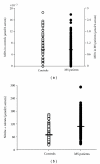Serum metabolic profile in multiple sclerosis patients
- PMID: 22096628
- PMCID: PMC3196932
- DOI: 10.1155/2011/167156
Serum metabolic profile in multiple sclerosis patients
Abstract
Multiple sclerosis (MS) is a progressive demyelinating process considered as an autoimmune disease, although the causes of this pathology have not been yet fully established. Similarly to other neurodegenerations, MS is characterized by a series of biochemical changes affecting to different extent neuronal functions; great attention has been given to oxidative/nitrosative stress and to alterations in mitochondrial functions. According to previous data, MS patients show significant changes in the circulating concentrations of different metabolites, although it is still unclear whether uric acid undergoes to decrease, increase, or no change under this pathological condition. In this study, we report the serum metabolic profile in terms of purines, pyrimidines, creatinine, malondialdehyde, ascorbic acid, nitrite, and nitrate in a group of 170 MS patients. The results show increase in circulating uric acid and other oxypurines (hypoxanthine and xanthine), as well as in uridine and β-pseudouridine. The concomitant increase in circulating creatinine, malondialdehyde, nitrite, and nitrate, and decrease in ascorbic acid, demonstrates that MS induces alteration in energy metabolism and in oxidants/antioxidants balance that can be monitored in serum of MS patients.
Figures





References
-
- Noseworthy JH. Progress in determining the causes and treatment of multiple sclerosis. Nature. 1999;399:A40–A47. - PubMed
-
- Steinman L. Multiple sclerosis: a coordinated immunological attack against myelin in the central nervous system. Cell. 1996;85(3):299–302. - PubMed
-
- Tiberio M, Chard DT, Altmann GR, et al. Metabolite changes in early relapsing-remitting multiple sclerosis. A two year follow-up study. Journal of Neurology. 2006;253(2):224–230. - PubMed
-
- Behl C. Oxidative stress in Alzheimer’s disease: implications for prevention and therapy. Sub-Cellular Biochemistry. 2005;38:65–78. - PubMed
-
- Gu Z, Nakamura T, Yao D, Shi ZQ, Lipton SA. Nitrosative and oxidative stress links dysfunctional ubiquitination to Parkinson’s disease. Cell Death and Differentiation. 2005;12(9):1202–1204. - PubMed
LinkOut - more resources
Full Text Sources
Other Literature Sources

